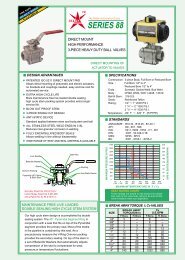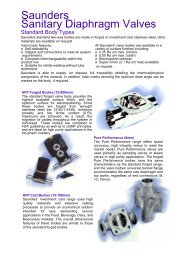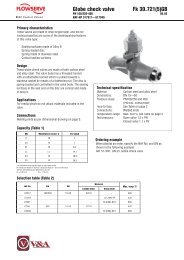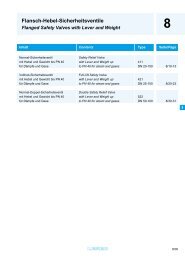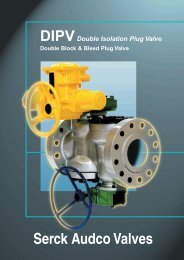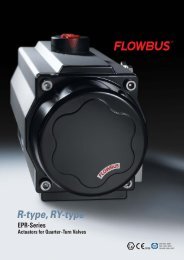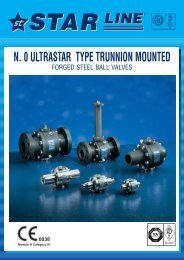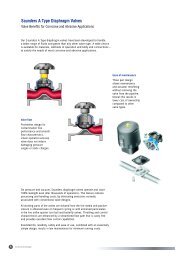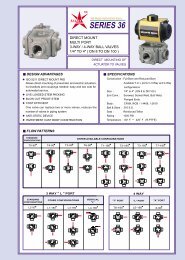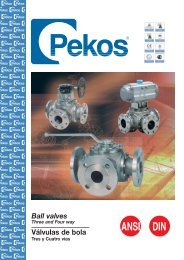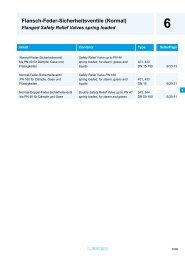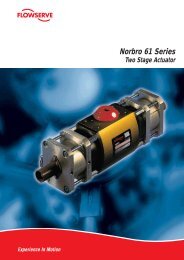Equipment/ functions - Process Valve Solutions
Equipment/ functions - Process Valve Solutions
Equipment/ functions - Process Valve Solutions
Create successful ePaper yourself
Turn your PDF publications into a flip-book with our unique Google optimized e-Paper software.
10<br />
<strong>Equipment</strong>/ <strong>functions</strong><br />
DUO limit switching/ intermediate position switches (option)<br />
With DUO limit switching an additional<br />
switching point can be set for each<br />
direction of rotation (intermediate<br />
position switches). The switching can<br />
be set to any valve position between<br />
the end positions. The switch will<br />
remain operated from set tripping<br />
point to end position if not more than<br />
120 turns of the hollow output shaft<br />
are in between.<br />
Limit and torque switches<br />
Versions<br />
The switch signal can be used for<br />
any purpose, e.g. to:<br />
■ signal a certain valve position<br />
tripped<br />
not<br />
tripped<br />
OPEN<br />
direction<br />
With the help of the switches, the<br />
mechanically measured travel (i.e.<br />
number of turns) and torque are converted<br />
into usable signals for the<br />
actuator controls. The switches are<br />
integrated into the control unit which<br />
contains four switches in the basic<br />
version:<br />
■ one limit switch each for the end<br />
positions OPEN and CLOSED,<br />
■ one torque switch each for the directions<br />
OPEN and CLOSE.<br />
The limit switches are tripped when<br />
an end position is reached and the<br />
torque switches are tripped when the<br />
set tripping torque is exceeded.<br />
■ to start an additional actuator<br />
which is mounted on a bypass<br />
valve<br />
■ to start or switch off any unit, e.g. a<br />
pump<br />
Switching<br />
points<br />
<strong>Valve</strong> position<br />
CLOSE<br />
direction<br />
If the actuator is supplied with<br />
DUO limit switching two more limit<br />
switches for intermediate positions<br />
are available.<br />
To meet the high demands regarding<br />
reliability, AUMA uses specially<br />
developed high quality<br />
microswitches with a snap action<br />
mechanism.<br />
In the basic version the switch contacts<br />
are of silver. For voltages<br />
between 5 V and 50 V and low current,<br />
switches with gold-plated contacts<br />
are recommended.<br />
Application/ Description Type of contacts<br />
Single switch Standard (NC and NO contacts not galvanically isolated) 1 NC and 1 NO contact<br />
(1 NC and 1 NO)<br />
Tandem switches (option) For switching two different potentials. The switches have two compartments with<br />
galvanically isolated switches in a common sealed housing. The two switches are<br />
operated together; one switch is leading, which should be used for signalisation.<br />
Triple switches (option) For applications where three different potentials are to be switched. The switch<br />
consists of one single and one tandem switch.<br />
Switch rating<br />
Type of current Switch rating Imax<br />
30 V 125 V 250 V<br />
AC (ind. load) cos ϕ = 0.8 5 A 5 A 5 A<br />
DC (resistive load) 2 A 0.5 A 0.4 A<br />
with gold plated contacts<br />
(recommended for controls with low voltage)<br />
Voltage min. 5 V, max. 50 V<br />
Current min. 4 mA, max. 400 mA<br />
Technical data<br />
2 NC and 2 NO contacts<br />
(2 NC und 2 NO)<br />
3 NC and 3 NO contacts<br />
(3 NC and 3 NO)<br />
Enclosure protection IP 66<br />
Operation via lever<br />
Contact elements two snap action contacts<br />
Contact material Silver (standard)<br />
Gold (option)<br />
Mechanical lifetime min. 2 x 10 6 cycles



